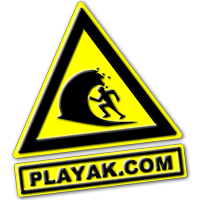This thread has got me thinking about first aid kit. Now i'm only a medical student (due to qualify soon) and don't claim to be a resus expert (although i fancy specialising in anaesthetics) but i do take part in a variety of sports and expeditions on land and water and have taken part in resusitations both in hospital and out on the street. As a result i've been thinking about what kit is appropriate to take to the place where i am going, my means of travel and my training level and i hope my thoughts might help others decide on what to bring.
Park and play: If you are at a centre that has good access for vehicles and it is easy to get to the casualty in a safe way, then only the most basic of equipment may be needed, (infact you're only gonna get a little bit of kit in a playboat). Triangular bandages, supportive bandages and the plasters that you see in 1st aid kits are pretty pointless here as you can just sit with the casualty untill help arrives rather than lashing up an ankle so they can hobble to safety . You can also do a bodge-it e.g. use a coat as a broad arm sling or any other material to hand. One exception to this might be an absorbent dressing, like the ones soldiers tape to their belt kit. These, if opened in the right way, provide a sterile dressing to a wound that can hold about a pint of blood, they are really easy to use and can provide alot of pressure to a wound helping to stem the flow. This is how most soldiers would treat a bullet wound to a comrade in the field. The only other dressing you might possibly need in addition to this (in this scenario) is something like steristrips to hold a wound together, but again you can bodge-it and use superglue if you have it (i have this on good authority from a surgeon). So thats about the only dressings i would have. But add to this at least one pair of rubber gloves for your own protection.
Next the A,B,C's, this sounds simple but it is the most fundamentally important routine to go through in any casualty whether you are a first aider on the street or head of the royal college of anaesthetists (the latter group will just do it better) and some simple, cheap gear will make it safer and more efficient. Firstly some sort of resus aid that protects you from your casualty by a one way valve is important and also something that helps to generate a seal over the casualty's face. For this i would recommend the \"pocket mask\" (available on the net). This fully covers the patient's mouth and nose and provides a one way valve for you to blow through. Cheaper and smaller alternatives would be a resus face sheild (e.g. ambukey face shield) this is small enough to fit on a key fob and provides a one way protective valve but doesn't form a tight seal round the patient's face.
Now you may have noticed i have skipped A for airway and gone straight to breathing. This is because this refers to the use of equipment to protect and maintain the airway which requires training not routinely done as part of basic first aid courses. They should not be used by anyone without them having tried it on at least a manakin previously. They include a plastic tube that sits in the mouth and holds the tongue of an unconscious patient free of the airway (called a guedel) , a tube that sits in the nostril of a patient and gets access to the airway that way (a nasopharyngeal tube) and a tube that is passed thgrough the mouth and sits just above the voice box held in place by an inflated rubber cuff (called a laryngeal mask airway L.M.A. or as some paramedics say: \"a fanny on a stick\" ). Now all this involves training that you need practical experience for and can't be learnt from a book so unless you are an EMT, paramedic, doctor or nurse then you probably shouldn't carry it.
C for circulation, if someone is bleeding a lot then the first thing for a first aider to do is to stop it! (assuming it is not internal) This is best done with the field dressing i mentioned earlier. Other methods (if the bleeding is heavy eg arterial) include tourniquets and application of pressure to specific points e.g. the groin for a bleeding leg (where the femoral artery runs). What i would say about these methods is that i don't know the current first aid guidlines on who can do them and in what circumstances, what i would say is that if the patient is painting the wall with blood then I would stop it by any means possible.
In addition to this, if you are trained you can give fluid resus which requires you to cannulate the patient and feed fluid (isotonic saline) directly into their sirculation.
I think i better stop! This has turned into a mamoth posting! And to think i was going to discuss sea kayaking expedition first aid kit! In summary.
Field dressing, pocket mask, steristrips, superglue, rubber gloves if you know some first aid, if you know more consider adding in cannulas, guedel airway, nasopharyngeal, LMA's, 1litre of saline, tourniquet. (if you are bringing them then you should know about sizes!)
These might seem excessive (and probably are) but can save a person from the things that kill them first (compromised airways). The bandages etc are not important unless you have to move someone or make them comfortable for extended time periods. Let the paramedics sort the non-life threatening stuff out when they arrive. PHEW!!!!!!
Sorry, that was way too long!




